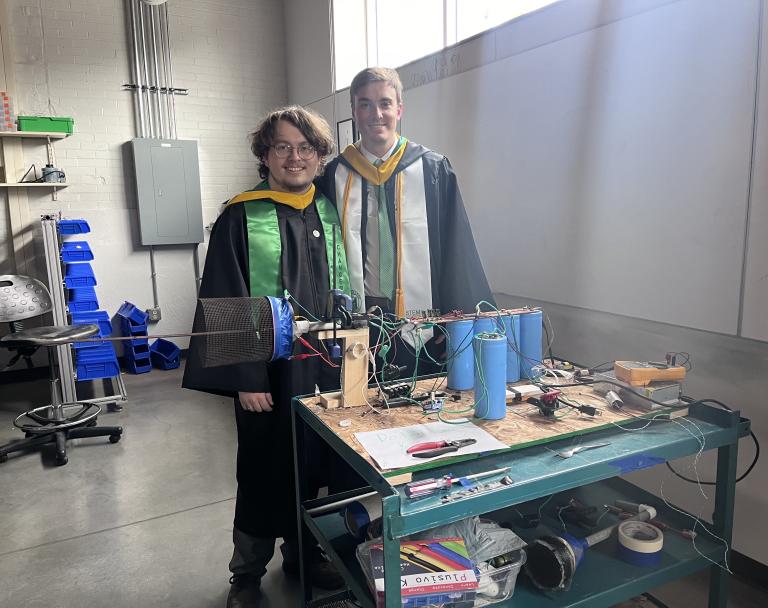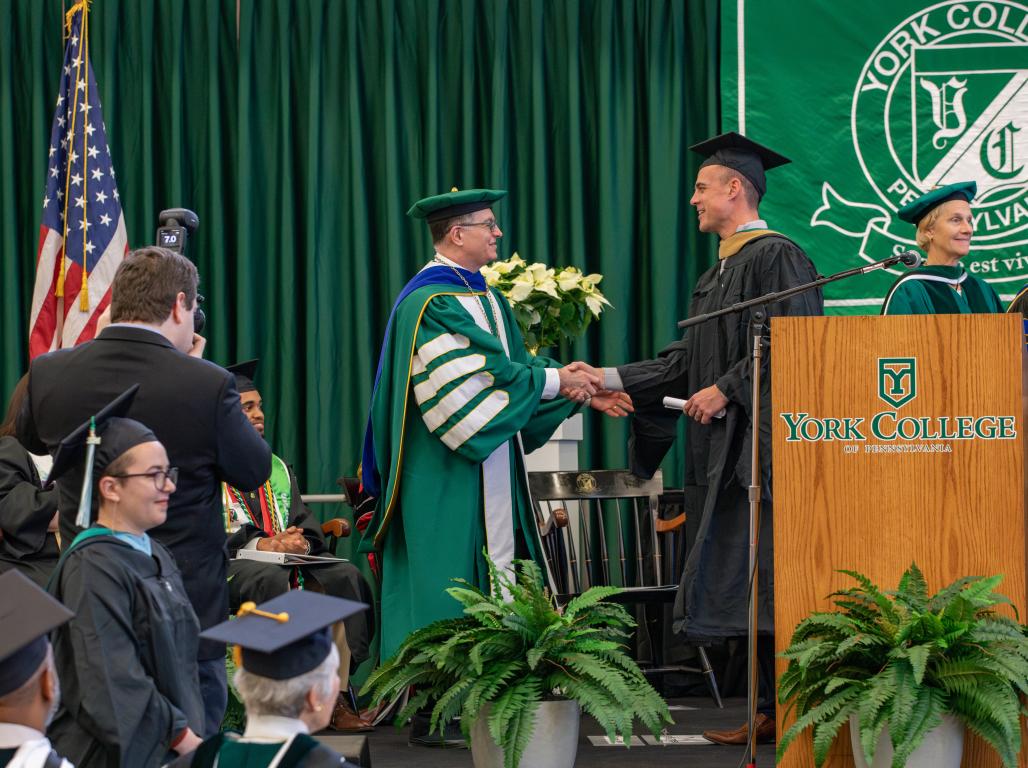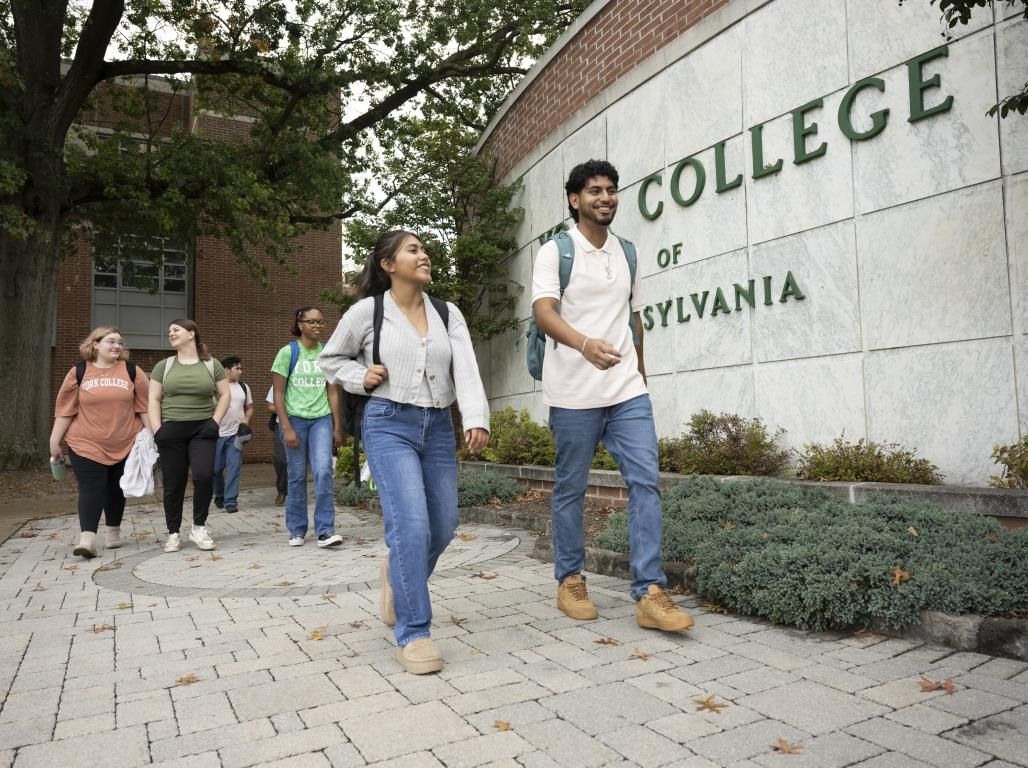Electrical Engineering majors James Hoopman and James Macneal, both August 2024 graduates, have spent their final year researching and developing a toroidal plasma accelerator.
Superheated, electrically charged plasma gas shoots at over 250 feet per second from the end of the toroid plasma accelerator built by York College of Pennsylvania Electrical Engineering majors James Hoopman and James Macneal. With the sound of a cannon blast and a flash of brilliant light, the glowing toroidal (doughnut-shaped) formation of plasma travels up to eight feet across the Kinsley Engineering Center lab before dissipating.
Hoopman and Macneal have embraced the spirit of innovation and hands-on learning that York College strives to provide. Guided by James Kearns, Ph.D., Associate Professor of Electrical and Computer Engineering, their project has the potential to open new doors in the world of plasma acceleration.
Hoopman and Macneal’s toroid plasma accelerator is a fascinating tool for advancing such applications as nuclear fusion for power generation or engine design for space travel. Designed for an open atmosphere environment, unlike many plasma accelerators that are constructed and operated in a vacuum, their uniquely configured device has helped extend the plasma’s lifespan significantly.
“A regular plasma might last just a few milliseconds, but our toroid formation device sustains it for up to 115 milliseconds,” Hoopman says.
A desirable setting for research
The roots of the project stretch back to Hoopman’s senior year of high school, when his interest in plasma physics began to take shape as he read research papers from the 1970s and ’80s. His fascination continued to grow through the COVID-19 quarantine period, when he experimented independently.
When it came time to choose a college, York College’s engineering co-op program caught Hoopman’s attention. The College was the only affordable institution near his home that offered this type of co-op, and because of its smaller size, he knew he’d have a lot of one-on-one time with his professors.
Macneal also wanted to attend a school with a strong engineering co-op program, and the College’s scholarships interested him.
Hoopman leveraged his high school research to gain admission to the College’s STEM Scholars program. When that program was defunded during his sophomore year, he thought his research was over. Dr. Kearns suggested that Hoopman and Macneal apply for an independent study program. The College approved their application and agreed to fund their research during the Spring 2024 semester.
Engineering in action
The pair’s accelerator stands out not only for its technical achievement but also its resourcefulness. Working on a tight budget and using 3D printing, copper conductors, a homemade spectrometer, and a homemade slow-motion camera, they experimented with various sizes and shapes of chambers to optimize toroidal formation and stability.
“Last semester, we did a lot of rapid prototyping, testing a lot of variables,” Macneal says.
For the Summer 2024 semester, they are going slower, moving from qualitative to quantitative data as they work to develop a smaller toroid plasma accelerator for a commercial client who is funding the next round of research.
In the process, Hoopman and Macneal made a groundbreaking discovery: helically confined plasma (HFP). It’s a potentially new plasma projection that Hoopman describes as thousands of plasmas strands rotating in a cylindrical formation. The HFP can move at a greater velocity, is more stable, and can travel a longer distance compared to toroid-shaped plasma.
When a toroid plasma hits a target, it rolls over it. When an HFP hits a target, it flattens into a disc, which means it will have more kinetic energy transfer, a key in generating energy through fusion. The duo plan to further analyze their plasma’s energy output this summer using their homemade high-speed spectrometer. Hoopman often shares their processes and findings on his @PlasmaFreak YouTube channel.
Challenges and triumphs
As they continue to conduct research and gain knowledge, Hoopman and Macneal credit York College for helping them develop a toolkit for problem-solving rather than offering ready-made solutions.
“They’ve taught us how to find what we need to work with,” Macneal says.
York College’s emphasis on hands-on learning and independent study has been instrumental in the project’s success and in securing future opportunities for Hoopman and Macneal. They have written a report that they hope to publish.
After the summer semester and their graduation, Hoopman will head to Johns Hopkins University’s Applied Physics Lab, where he plans to pursue a master’s degree while continuing his research. Macneal will move to Colorado and likely work in the embedded systems field. Both highly recommend York College’s Engineering program for students interested in project-based, personalized learning.
“If you are someone who is hands-on-minded, I’d definitely recommend doing an independent study,” Hoopman says. “This is the opportunity for students to really get hands-on.”
“The main thing you should keep in mind at York is they can’t give you all the information,” Macneal says, “but they’re teaching you how to think, and that is much more important than learning a bunch of facts.”





